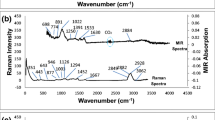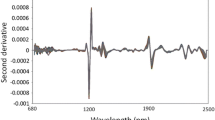Abstract
This work is focused on a new strategy for quality analysis of brewing malt using near infrared (NIR) spectra taken from malt kernels in reflection as fingerprint to classify directly to processability of malt. One part of the study deals with calibrating a partial least squares discriminant analysis (PLS-DA) model with NIR spectra classifying malt into the three different classes resulting in a five-component model. Therefore, suitable pre-processing algorithms for spectra were tested. The target for calibration is given by an expert opinion on lautering runs (filtration step in brewing). The accuracy achieved using pilot plant data in relation to the expert classification “good”, “normal” and “bad” was 90.6 and 92.7 % in validation and calibration, respectively. The second part of the study is presenting the transfer of these analytical tools to industrial scale. This was established via adjustment to corresponding system conditions. The accuracy achieved using similar algorithms as mentioned before was 93.6 and 76.6 % in calibration and validation, respectively. Independent from this, two numerical possibilities were established for automatic process evaluation classifying the different processes in three categories (good, normal, bad): the first is calculating the residual standard deviation of a process based on multivariate statistical process control and the second is discretizing each process individually based on its single online trends. Both methods were compared to the expert opinion coinciding with 84 and 85 %, respectively.












Similar content being viewed by others
Abbreviations
- µ:
-
Centroid of class S
- A:
-
Number of components
- ABOF:
-
Angle-based outlier factor
- B :
-
Matrix of regression parameters
- b 0 :
-
Vector of intercepts
- d():
-
Distance
- e i :
-
Vector of residuals
- FAN:
-
Free amino nitrogen
- hi :
-
Leverage
- MLR:
-
Multilinear regression
- MSC:
-
Multiplicative scatter correction
- MSPC:
-
Multivariate statistical process control
- n:
-
Number of sampling points
- NAS:
-
Net analyte signals
- NIR:
-
Near infrared
- p:
-
Polynomial degree
- p, P :
-
Vector/matrix of X-loadings
- PC:
-
Principal components
- PCA:
-
Principal component analysis
- PLS-DA:
-
Partial least squares discriminant analysis
- PLS(R):
-
Partial least squares (regression)
- q, Q :
-
Vector/matrix of Y-loadings
- RMSE:
-
Root mean squared error
- RSD:
-
Residual standard deviation
- S:
-
Classes
- s P , b, c :
-
Vectors representing data point in multidimensional space
- SSE:
-
Sum of squares
- STA:
-
Single trend analysis
- sVAST:
-
Supervised variable stability scaling
- SVD:
-
Singular value decomposition
- S X , S Y :
-
Diagonal matrix with standard deviation
- t, T :
-
Vector/matrix of X-scores
- VAST:
-
Variable stability scaling
- VIP:
-
Variable importance in the projection
- Vt :
-
Ratio of variance
- w :
-
Vector of weight factors
- w, W :
-
Weighted loading vector/matrix
- x :
-
Vector of input values/NIR spectrum
- X :
-
Matrix of input data
- X T :
-
Matrix of restructured PLS scores
- Y :
-
Matrix of targets
- σ:
-
Variance
- τ :
-
Vector of scaled time frames
- ^:
-
Predicted
- ¯:
-
Mean
- a, i, j, k, n, p:
-
Counter
- s:
-
Scaled
- turb:
-
Turbidity
References
Rath F (2006)Möglichkeiten der Vorhersage von Verarbeitungsrisiken im industriellen Läuterprozess auf der Basis von Laboranalysen des Malzes. In: 35. Internationales Braugerstenseminar
Nischwitz R, Cole NW, MacLeod L (1999) Malting for brewhouse performance. J Inst Brew 105(4):219–227
Schwill-Miedaner A, Flocke R, Sommer K (1997) Zusammenhänge zwischen Malzauflösung und Partikelgrößenverteilung des Schrotes. Brauwelt 12:412–416
Ferenczy L, Bendek G (1991) Untersuchung der Veränderung der Würzeproteinzusammensetzung während des Maischprozesses mit der SDS-PAGE-Gelelektrophorese und deren Einfluß auf das Abläutern. Monatsschrift fuer Brauwissenschaft 44(5):191–200
Moll M, Lenoel M, Flayeux R, Laperche S, Leclerc D, Baluais G (1989) The new Tepral method for malt extract determination. ASBC J 47(1):14–17
Sjoholm K, Pietila K, Home S, Aarts R, Jaakkola N (1994) Evaluation of Lautering Performance of Malt. Monatsschrift fuer Brauwissenschaft 47(5):165–171
Ellis DI, Broadhurst D, Kell DB, Rowland JJ, Goodacre R (2002) Rapid and quantitative detection of the microbial spoilage of meat by fourier transform infrared spectroscopy and machine learning. Appl Environ Microbiol 68:2822–8282
Stippl V, Delgado A, Becker T (2002) Optical method for the in situ measurement of pH-value during high pressure treatment of foods. High Pressure Res 22:757–761
Nicolaï BM, Beullens K, Bobelyn E, Peirs A, Saeys W, Theron KI, Lammertyn J (2007) Nondestructive measurement of fruit and vegetable quality by means of NIR spectroscopy: a review. Postharvest Biol Technol 46 (2):99–118. doi:10.1016/j.postharvbio.2007.06.024
Goyal S (2013) Predicting properties of cereals using artificial neural networks: A review. Sci J Crop Sci 2(7):95–115
Meurens M, Yan SH (2002) Applications of vibrational spectroscopy in brewing. Handbook of Vibrational Spectroscopy
Møller B (2004) Near infrared transmission spectra of barley of malting grade represent a physical-chemical fingerprint of the sample that is able to predict germinative vigour in a multivariate data evaluation model. J Inst Brew 110(1):18–33
Nielsen JP, Bro R, Larsen J, Munck L (2002) Application of Fuzzy Logic and Near Infrared Spectroscopy for Malt Quality Evaluation. J Inst Brew 108(4):444–451. doi:10.1002/j.2050-0416.2002.tb00574.x
Anger H-M (2006) Brautechnische Analysenmethoden-Rohstoffe. Selbstverlag der Mitteleuropäische Brautechnische Analysenkommission, Freising
Holtz C, Krause D, Hussein MA, Gastl M, Becker T (2014) Lautering performance prediction from malt by combining whole near-infrared spectral information with lautering process evaluation as reference values. J Am Soc Brew Chem (in press)
Wold S, Kettaneh N, Fridén H, Holmberg A (1998) Modelling and diagnostics of batch processes and analogous kinetic experiments. Chemometr Intell Lab Syst 44 (1–2):331–340. doi:10.1016/S0169-7439(98)00162-2
Whitehead IJ (2012) Soft sensing: using multivariate analysis for yeast propagation monitoring. Diplomarbeit, TU München
Smilde A, Bro R, Geladi P (2004) Multi-way analysis. Applications in the chemical sciences. Wiley, Chichester
Axelson D (2010) Data Preprocessing for Chemometric and Metabonomic Analysis. Kingston, Ontario
Kessler W (2007) Multivariate Datenanalyse. Wiley-VCH Verlag GmbH & Co, KGaA, Weinheim
Geladi P, Kowalski BR (1986) Partial least squares regression: a tutorial. Anal Chim Acta 185:1–17
Wold H (1974) Causal flows with latent variables. Partings of the ways in the light of NIPALS modelling. Eur Econ Rev 5(1):67–86
Lindgren F, Geladi P, Wold S (1993) The kernel algorithm for PLS. J Chemom 7(1):45–59. doi:10.1002/cem.1180070104
Krause D, Schöck T, Hussein MA, Becker T (2011) Ultrasonic characterization of aqueous solutions with varying sugar and ethanol content using multivariate regression methods. J Chemometr 25(4):216–223. doi:10.1002/cem.1384
Golub GH, Reinsch C (1970) Singular value decomposition and least squares solutions. Numer Math 14(5):403–420. doi:10.1007/BF02163027
De Jong S, Ter Braak CJF (1994) Comments on the PLS kernel algorithm. J Chemom 8(2):169–174. doi:10.1002/cem.1180080208
Martens H, Næs T (1991) Multivariate calibration. Wiley
Jørgensen B, Goegebeur Y (2012) Module 8: partial least squares regression II. http://statmaster.sdu.dk/courses/ST02/index.html. Accessed 03.05. 2012
Barker MR, Rayens W (2003) Partial least squares for discrimination. J Chemom 17(3):166–173
Serrano CC, Gutierrez NB (2011) Partial least square discriminant analysis (PLS-DA) for bankruptcy prediction
Indahl UG, Martens H, Næs T (2007) From dummy regression to prior probabilities in PLS-DA. J Chemometrics 21:529–536. doi:10.1002/cem.1061
Hicham Nocairi EMQ, Evelyne Vigneau, Dominique Bertrand (2005) Discrimination on latent components with respect to patterns. Application to multicollinear data original. Comput Stat Data Anal 1 (1):139–147
Teófilo RF, Martins JPA, Ferreira MMC (2009) Sorting variables by using informative vectors as a strategy for feature selection in multivariate regression. J Chemom 23(1):32–48. doi:10.1002/cem.1192
Sorol N, Arancibia E, Bortolato SA, Olivieri AC (2010) Visible/near infrared-partial least-squares analysis of Brix in sugar cane juice A test field for variable selection methods. Chemometr Intell Lab Syst 102(2):100–109. doi:10.1016/j.chemolab.2010.04.009
Kriegel H-P, Hubert MS, Zimek A (2008) Angle-based outlier detection in high-dimensional data. Proceedings of the 14th ACM SIGKDD international conference on Knowledge discovery and data mining, pp 444–452. doi:10.1145/1401890.1401946
Botella C, Ferré J, Boqué R (2010) Outlier detection and ambiguity detection for microarray data in probabilistic discriminant partial least squares regression. J Chemom 24(7–8):434–443. doi:10.1002/cem.1304
Hastie T, Tibshirani R, Friedman J (2001) The elements of statistical learning, vol 1. Springer, New York
Melgani F, Bazi Y (2008) Classification of electrocardiogram signals with support vector machines and particle swarm optimization. IEEE Trans Inform Technol Biomed 12(5):667–677
Chuang L-Y, Yang C-H, Yang C-H (2009) Tabu search and binary particle swarm optimization for feature selection using microarray data. J Comput Biol 16(12):1689–1703
Benoudjit N, Melgani F, Bouzgou H (2009) Multiple regression systems for spectrophotometric data analysis. Chemometr Intell Lab Syst 95(2):144–149. doi:10.1016/j.chemolab.2008.10.001
Shi Z, Cogdill RP, Martens H, Anderson CA (2010) Optical coefficient-based multivariate calibration on near-infrared spectroscopy. J Chemom 24(5):288–299. doi:10.1002/cem.1301
Acknowledgments
This work was partially funded by the “Bundesministerium fuer Wirtschaft und Technologie” (via AiF) through the research project AIF 16529 N/1 in cooperation with “Wissenschaftsförderung der Deutschen Brauwirtschaft e.V”.
Conflict of interest
None.
Compliance with Ethics Requirements
This article does not contain any studies with human or animal subjects.
Author information
Authors and Affiliations
Corresponding author
Rights and permissions
About this article
Cite this article
Krause, D., Holtz, C., Gastl, M. et al. NIR and PLS discriminant analysis for predicting the processability of malt during lautering. Eur Food Res Technol 240, 831–846 (2015). https://doi.org/10.1007/s00217-014-2389-3
Received:
Revised:
Accepted:
Published:
Issue Date:
DOI: https://doi.org/10.1007/s00217-014-2389-3




